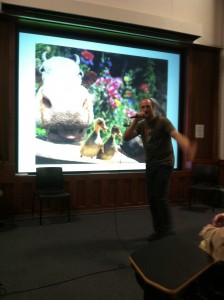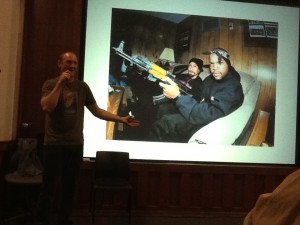 I recently pulled out an old paper I wrote as an undergraduate examining Joseph Conrad & D.H. Lawrence using Darwinian theory of consciousness & self-deception derived from Richard Alexander’s “Evolution of the Human Psyche.” This would have been 1995 or 1996 or so, thus a good decade or more before I’d even heard of Literary Darwinism, let alone realize I was doing it. Narcissistic as it sounds, I impressed myself, as the paper holds up, so I’ve been poking at it here & there to get it in shape to submit for possible publication. In the meantime, I just happened to download the audiobook of Ray Bradbury’s Fahrenheit 451, not knowing anything about it whatsoever, as it was one of the few audiobooks available thru Tuscaloosa’s digital online library that looked compelling enough to help me dissociate from my usual thinking too much. Probably not too ironically, it’s main conceit is self-deception!
I recently pulled out an old paper I wrote as an undergraduate examining Joseph Conrad & D.H. Lawrence using Darwinian theory of consciousness & self-deception derived from Richard Alexander’s “Evolution of the Human Psyche.” This would have been 1995 or 1996 or so, thus a good decade or more before I’d even heard of Literary Darwinism, let alone realize I was doing it. Narcissistic as it sounds, I impressed myself, as the paper holds up, so I’ve been poking at it here & there to get it in shape to submit for possible publication. In the meantime, I just happened to download the audiobook of Ray Bradbury’s Fahrenheit 451, not knowing anything about it whatsoever, as it was one of the few audiobooks available thru Tuscaloosa’s digital online library that looked compelling enough to help me dissociate from my usual thinking too much. Probably not too ironically, it’s main conceit is self-deception!
I say not too ironic because I think classic literature can be analyzed successfully using any number of Darwinian tropes (do I think that or did Joseph Carroll say that & now I think it? when will I start thinking for myself, the protagonist asks). That’s what makes it canonical, as Joseph Carroll has pointed out–it conveys something fundamental about the human condition &, thus, can be analyzed vis-a-vis Darwinism. Though this seems intuitive, it was striking to those who read my paper in 1995, as I recall. I couldn’t come up with anything to tie all the books together we were assigned to read & write about, but I was reading sociobiological theory for other papers I was working on & thought I could tie them all together from the perspective of “scenario-building.” I recall my English professor expressing delight at the novelty of it & had me read the paper aloud to the rest of the class (honestly, I recall writing about a Virginia Wolfe book from the Darwinian perspective & reading that, so I may be getting my stories crossed & there is another such paper lurking somewhere in my files). And this Ray Bradbury book is probably the first canonical piece I’ve digested in some years, & the Darwinian trope fairly screams at me here too.
In the book, a future U.S. has banned books because they upset people too much. Some minority is always upset by something, yet everyone wants to be happy. So, to facilitate this, they ban all books & punish people who keep them secretly by burning their houses down with the books inside. The protagonist is one of these “firemen,” whose new job in a future where houses can no longer catch on fire on accident, is to protect the public not from fire but by fire. In this world, people have TVs in their homes that are literally walls of their houses & on full blast or playing thru ear buds literally all the time. When they aren’t on to distract them, people become anxious (anticipating flatscreen TVs & iPhones, methinks). If these distractions don’t work, people go driving at high speed (55 mph in the minimum speed limit) & run over & kill small animals for fun (anticipating “The Itchy & Scratchy Show” & themes from The Simpsons). If they get anxious at night, they take sleeping pills to prevent dreaming (“Mother’s Little Helper”).
A neighbor girl–a questioning child in a world where children are hidden away in boarding schools & kept in desks with homework for 9 hours/day to wear them out & prevent them free time to think–keeps asking him if he’s ever wondered why this our that. Of course Why? is the ultimate evolution question, though the book doesn’t address this directly (at least not yet–I’m not actually finished). She agitates him by setting him to thinking, but he is so flattered & charmed by her that his mind begins to open. When she is killed by a speeding car for, almost literally, stopping to smell the roses, the fireman becomes obsessed with recovering his awareness & inflicting it on others, finding guilty satisfaction when he reads a poem to his wife’s yenta friends, for instance, leading one of them to erupt in tears she does not understand.
Fahrenheit 451‘s central tension, for me, is in extolling benefits & costs of consciousness. This future U.S. society has taken the position that, given the conflicting wants & demands of the exponentially increasing population, ignorance is, indeed, & literally, bliss. But the bliss is fragile & does not appreciate the demands of an impending war that will rend the society apart & the need of awareness & pain to be able to learn the lessons of history, protect itself, & heal. As student blogger Adriana Guardans Godo asks for her English paper,
Can happiness really be achieved through self-deception and conformity, or is challenging the truth what makes us content?
I am anticipating what I think is going to happen a bit, but it reminds me of neuroscientist Antonio Damasio‘s thesis on the approach & withdraw systems in, I think, Decartes’ Error. The approach or pleasure system is separate from the pain or withdraw system because they are for fundamentally different purposes & vary in importance. If you fail to act on a possible reward, you might suffer long-term consequences (like failing to act on a possible reproductive opportunity) but with time to make up for it. If you fail to act on a pain, you could die, with obvious immediate consequences to your evolutionary viability. Consequently, pain & suffering are more memorable than joy & reward. It’s important to recall painful mistakes to avoid making them again. Thus, in Bradbury’s dystopia, the social purgation of unpleasant memory has doomed them to some future catastrophe. The weak link here, & in my entire conception of this, is that most mammals have learned aversive responses to pain or bad tastes without the costs of consciousness…how to rectify that…?
I’ll let you know, when I get there, if indeed it’s as bleak as all that & how I’m going to work this into my manuscript & theoretical models.
















 So it seems to be with the silver foxes. Once an environmental condition pushes silver foxes (or wolves before them) one way (luring tame ones to their yummy debris & handouts) or another (spooking the nervous ones to run away), a cascade of epigenetic mechanisms pushes them further along. At that point, according to this model, tame ones cannot become anxious/aggressive & vice versa. While cute silver foxes that you can cuddle with get all the press, the less publicized but equally fascinating is the aggressive foxes that want to rip your face off.
So it seems to be with the silver foxes. Once an environmental condition pushes silver foxes (or wolves before them) one way (luring tame ones to their yummy debris & handouts) or another (spooking the nervous ones to run away), a cascade of epigenetic mechanisms pushes them further along. At that point, according to this model, tame ones cannot become anxious/aggressive & vice versa. While cute silver foxes that you can cuddle with get all the press, the less publicized but equally fascinating is the aggressive foxes that want to rip your face off.
 There are two TPH genes, & it is the 2nd one (TPH2), expressed in the brain & responsible for the central nervous system, that effects 5-HT & seems to be responsible for aggressive behavior.
There are two TPH genes, & it is the 2nd one (TPH2), expressed in the brain & responsible for the central nervous system, that effects 5-HT & seems to be responsible for aggressive behavior. If any one of these mechanisms or either of these pathways influences aggression, they will interact with the environment to mutually reinforce themselves & push the marble down toward the other pathway too. In other words, if the stress of domestication bumped the marble off the plane, having even only a slightly higher tendency of aggression relative to tameness will result in amplification of the entire aggression pathway, even if the environmental conditions of captivity are thereafter removed (i.e., the animal is released). What still remains to be clarified is how the initial brain changes occur & the roles of other mechanisms in the system.
If any one of these mechanisms or either of these pathways influences aggression, they will interact with the environment to mutually reinforce themselves & push the marble down toward the other pathway too. In other words, if the stress of domestication bumped the marble off the plane, having even only a slightly higher tendency of aggression relative to tameness will result in amplification of the entire aggression pathway, even if the environmental conditions of captivity are thereafter removed (i.e., the animal is released). What still remains to be clarified is how the initial brain changes occur & the roles of other mechanisms in the system.